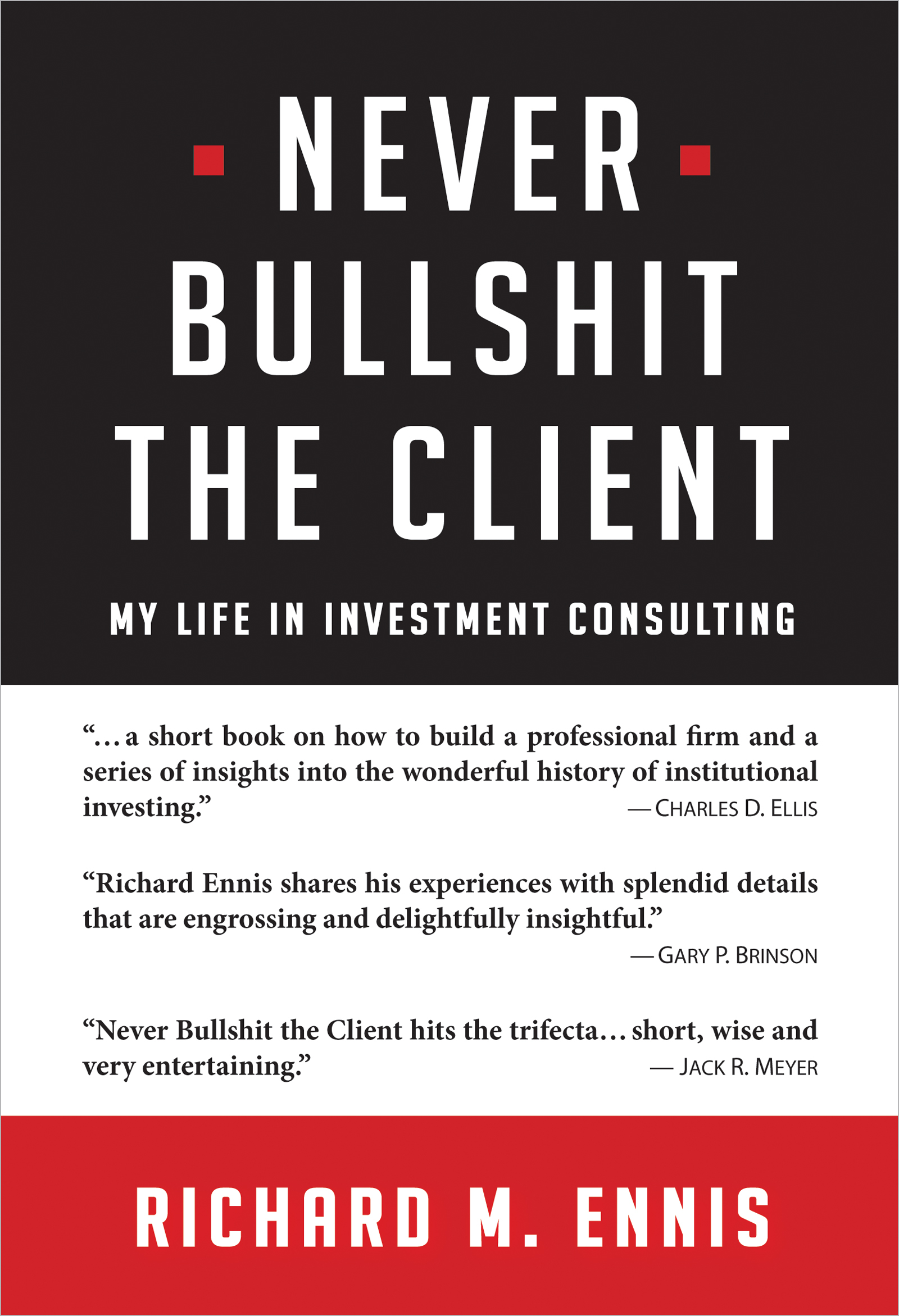Signature EnnisKnupp Advisory Themes
Advisory themes played a vital role in the work of EnnisKnupp. We wanted all the clients to get the firm’s best thinking. As a means to that end we set out the firm’s position in various areas so that clients got the same advice, circumstances warranting. There were never more than 10 or so positions, or themes, most of which derived from our research and writing. We tried to put them down on paper from time to time, but that proved superfluous. The positions were forged in our internal discussions and day-to-day work. We knew them like we knew our own names. Here is a brief description of some of the most enduring EnnisKnupp advisory themes.
Indexing
Our advice to new clients was to put one-half their portfolio in stock and bond index funds as a start. The evidence in support of this approach began to emerge in the mid-1960s and was cumulatively overwhelming. A corollary to the 50%-indexed position was to then increase or decrease the indexed percentage based on the collective success of active managers over time. Clients that did this saw the passive percentage of their portfolios rise fairly steadily, with some approaching 100%.
Avoid Closet Indexing
The term “closet indexing” originated to describe a portfolio manager’s hugging its benchmark to guard against significant underperformance. The term can be applied more broadly, as well, to institutional investors that use too many active managers to their own economic detriment.“Diversifying” among active managers is insidious and wasteful. The common practice was to use several active stock portfolio managers with “complementary” styles. It was not unusual to see 10 or more active strategies combined in this fashion. Here we did two things. First, we published an article in the Journal of Portfolio Management demonstrating empirically the failure of “style diversification” in fund-of-manager funds. These were pooled investment funds constructed by experts using numerous sub-managers with differing styles. The funds we examined underperformed their benchmarks by an average of 1.3 percentage points a year, an amount approximately equal to their expenses. The result did not surprise us.
The other thing we did was to create software to quantify the effects of closet indexing in our clients’ own portfolios. Our Implied Expectations model, as it was known, illustrated for clients their expected gain, or “alpha,” from active management given their collective active investment exposures and degree of diversification. This usually amounted to just a few basis points per year before fees. It was the inevitable result of having a collective style exposure similar to that of the market plus very broad security-level diversification. In other words, it is hard to perform very differently from the market when your “active” portfolio closely resembles the market.
The cure for closet indexing is fewer managers, more concentrated managers, more indexing or a combination of the three. This was our prescription.
Foreign Stocks
Roughly half of the common stock opportunity set lies outside the United States. It is too large a segment to ignore in achieving efficient diversification. Recognizing the importance of peer comparisons in performance evaluation, however, we were cautious not to overdo international diversification. Accordingly, we typically recommended that non-U.S. equities — in developed and emerging markets — constitute approximately 20% of total equities. This was more progressive than the typical allocation but not extreme.
Foreign Bonds
We advised against a policy allocation to non-dollar bonds. The currency risk of such bonds more than offsets the benefit of diversifying interest rate movements across country markets.
Active Management
A manager research analyst can consider many factors in evaluating whether or not a particular active manager is likely to beat the market. One criterion was paramount in EnnisKnupp’s evaluation of active managers, namely, the nature of a manager' s comparative advantage, or edge. Active money management is highly competitive. Markets are efficient enough and costs are such that a manager needs more than really smart people and the other attributes their marketers customarily trumpet. The manager needs something others do not have and cannot easily acquire — an edge.We were skeptical of the conventional wisdom that smaller stocks tend to be ignored by analysts and were thus a fertile area for active management. We presented our research findings to the contrary in the Journal of Portfolio Management in an article titled “The Small-Cap Alpha Myth” that won a Bernstein Fabozzi Jacobs Levy Award.
Hedge Funds
One-and-twenty or two-and-twenty should have been enough to scare off investors experienced with active management of securities portfolios. That level of charge is a staggering burden. Our research, published in JPM, and earning an award there, provided other reasons to avoid hedge funds. For one, they are not market neutral; portfolios of hedge funds exhibit significant exposure to various market factors. Another problem arises from the stale pricing of less liquid hedge fund holdings, which gives the illusion of low volatility. Finally, the performance of diversified hedge fund strategies had been lackluster when all the costs, risks and liquidity were accounted for.All the advisory themes revolved around a central theme of achieving economic efficiency — control risk, control costs, get paid for the risk taken.
EnnisKnupp’s use of advisory themes served the firm well. They provided a means of ensuring all the clients got our best thinking. They were also important in establishing and making-known the firm’s identity — what it stood for.

